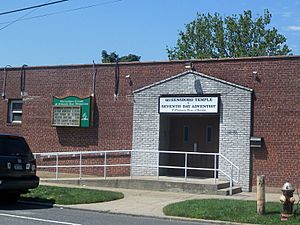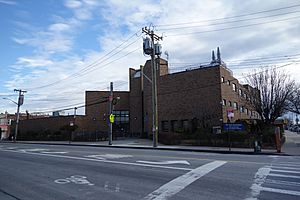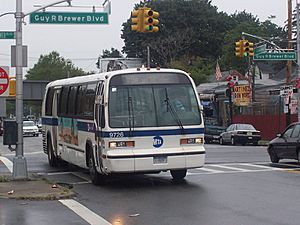South Jamaica, Queens facts for kids
Quick facts for kids
South Jamaica
|
|
|---|---|
|
Neighborhood of Queens
|
|

A Seventh Day Adventist church in South Jamaica
|
|
| Country | |
| State | |
| City | |
| County/Borough | |
| Community District | Queens 12 |
| Named for | The Lenape word Yameco meaning "beaver" |
| Population
(2010)
|
|
| • Total | 32,496 |
| Race/Ethnicity | |
| • Black | 72.2% |
| • Hispanic | 15.2 |
| • Asian | 5.2 |
| • White | 1.0 |
| • Other/Multiracial | 6.4 |
| Time zone | UTC−5 (EST) |
| • Summer (DST) | UTC−4 (EDT) |
| ZIP Codes |
11433, 11434, 11435, 11436
|
| Area codes | 718, 347, 929, and 917 |
South Jamaica (also known as "The Southside") is a neighborhood in the borough of Queens in New York City. It is located just south of downtown Jamaica. The neighborhood is mainly for homes and has residents from different income levels.
South Jamaica is part of Queens Community District 12. Its ZIP Codes are 11433 through 11436. The New York City Police Department's 113th and 103rd Precincts keep the area safe. Local politicians from the New York City Council's 27th and 28th Districts represent the community.
Contents
- Where is South Jamaica Located?
- What are South Jamaica's Nicknames?
- A Brief History of South Jamaica
- Who Lives in South Jamaica?
- Homes in South Jamaica
- Post Offices and ZIP Codes
- Schools and Learning
- Parks and Fun Activities
- Interesting Places to See
- Getting Around: Transportation
- Famous People From South Jamaica
Where is South Jamaica Located?
South Jamaica is generally found south of Downtown Jamaica. The Van Wyck Expressway is to its west, and Merrick Boulevard is to its east. The John F. Kennedy International Airport is located south of the neighborhood, across the Belt Parkway.
This area shares borders with other neighborhoods. These include St. Albans to the east and Springfield Gardens to the south. Some maps show a southern part of South Jamaica called Baisley Park. This area includes Baisley Pond Park and the Baisley Park Houses.
What are South Jamaica's Nicknames?
South Jamaica is often called "Southside" or "Southside Jamaica." This name comes from its location in the southern part of the greater Jamaica area. It also reflects the people who live there. The "South Side" nickname has been used since the early 1900s.
A Brief History of South Jamaica
How South Jamaica Got Its Name
South Jamaica is named because it is south of Jamaica. The name "Jamaica" comes from the Lenape word Yameco, which means "beaver." This is why there was once a place called Beaver Pond near Jamaica and South Jamaica. For a while in the 20th century, the neighborhood was also known as Cedar Manor.
Early Days: From Farms to Homes (1600s-1930s)
In the 1800s, South Jamaica was mostly farmland. Some of the first important places built here were Prospect Cemetery (opened in 1668) and St. Monica's Church (around 1857). Baisley Pond, a pond made by farmers, became part of the city's water supply in 1852.
The Jamaica Race Course, a place for horse racing, opened in 1894. Around the same time, new ways to travel came to the neighborhood. A streetcar line opened in 1896, connecting downtown Jamaica to the racetrack. The Cedar Manor train station opened in 1906. Baisley Pond Park became a city park in 1919.
In the 1920s, many new houses were built, and the number of people living here grew very quickly. Many African Americans moved into the neighborhood. By the 1930s, South Jamaica was mostly Black, though some White residents still lived there. At this time, the area faced many challenges. Homes were crowded, and many did not have modern things like electricity or indoor plumbing. The racetrack was also seen as a problem, making property values go down.
Making South Jamaica Better: Urban Renewal
Starting in 1939, the city began projects to improve the neighborhood. They built new public housing, which are homes for people with lower incomes. The first project was the South Jamaica Houses, opened in 1940. Another part opened in 1954.
In the 1950s, city planner Robert Moses helped make plans to replace the Jamaica Race Course. The plans included more public housing and possibly a new stadium for the Brooklyn Dodgers baseball team. The racetrack closed in 1959 and was torn down in 1960. The land was then used for an expanded Aqueduct Racetrack.
More new housing was built, like the Baisley Park Houses in 1961. Rochdale Village opened in 1963. It brought the first supermarkets and shopping centers to the area. By this time, most people in the neighborhood were Black, except for Rochdale Village, which had people of different races.
In 1970, plans were made to build a permanent campus for York College. This college campus, though delayed by money problems, started being built in 1980 and opened in 1988.
Changes in the Late 20th Century
Even with all the new buildings, South Jamaica was still seen as an area with many challenges in 1966. It was part of a national effort to help communities facing poverty.
South Jamaica Today: 2000s and Beyond
In the 2000s, South Jamaica has become much safer and a better place to live. Crime rates have dropped a lot since the 1990s. For example, major crime in the police precinct that covers South Jamaica went down by 76 percent between 1993 and 2010.
Who Lives in South Jamaica?
Based on information from the 2020 United States Census, South Jamaica had a population of 270,688 people. Most residents are African American, many with roots in the Afro-Caribbean islands.
In recent years, the Hispanic community has grown. People from countries like Mexico, El Salvador, Puerto Rico, and the Dominican Republic have moved here. There are also many people from Guyana and Bangladesh. Smaller groups of Haitians, Pakistanis, and Trinidadians also live in the area.
Homes in South Jamaica
South Jamaica is mostly a middle-class community. It has many one- and two-family houses, some built in the 1960s and some newer. A small part of South Jamaica is called Bricktown because it has many brick row houses.
There are also some apartment buildings and public housing projects. These include the NYCHA-run Baisley Park Houses and South Jamaica Houses. Other large housing areas are Rochdale Village and Cedar Manor Co-op.
Post Offices and ZIP Codes
South Jamaica uses several ZIP Codes. These are 11433, 11434, 11435, and 11436. The United States Post Office has a branch called Rochdale Village Station at 165-100 Baisley Boulevard.
Schools and Learning
Public and Charter Schools
South Jamaica has many elementary schools:
- Samuel Huntington School (P.S. 40)
- William Wordsworth School (P.S. 48), known for its Art Deco design.
- Walter Francis Bishop School (P.S. 160)
- P.S. 123
- Edward K. Ellington School (P.S. 140), named after Duke Ellington.
- Ruby S. Couche Elementary School (P.S. 30) and P.S. 354
- Lyndon B. Johnson School (P.S. 223), named after U.S. President Lyndon B. Johnson.
- Clarence Witherspoon School (P.S. 45)
- Talfourd Lawn Elementary School (P.S. 50)
- Thurgood Marshall Magnet School (P.S. 80), named after Thurgood Marshall.
- Rochdale Early Advantage Charter School
Middle and junior high schools include:
- Junior High School 40
- Richard Grossley Junior High School (J.H.S. 8)
- Eagle Academy for Young Men of Southeast Queens (Eagle Academy III), which is both a middle and high school.
- Catherine and Count Basie School (M.S. 72)
- York Early College Academy, a middle and high school.
High schools in the area are:
- August Martin High School, a school focused on aviation.
- Eagle Academy for Young Men III
- The High School for Law Enforcement and Public Safety
- Queens High School for the Sciences, a special high school located on the York College campus.
- York Early College Academy
Other schools include the Queens Transitional Center, which helps students with special needs.
Colleges and Universities
CUNY York College has its campus at the northern end of South Jamaica.
Libraries
The Queens Public Library has three branches in South Jamaica:
- The Baisley Park branch
- The Rochdale Village branch
- The South Jamaica branch
Parks and Fun Activities
Baisley Pond Park is a large outdoor space with over 100 acres. It includes a 30-acre pond, perfect for enjoying nature.
Interesting Places to See
St. Monica's Church, St. Monica's Cemetery, and Prospect Cemetery are all located on the York College campus.
The Jamaica Race Course, a former horse racing track, was once in South Jamaica. Now, Rochdale Village stands on that site.
Getting Around: Transportation
The AirTrain JFK is an elevated train that takes people between Jamaica and JFK International Airport. It passes over the Van Wyck Expressway without stopping in South Jamaica.
Many MTA bus lines serve the neighborhood. These include the Q4, Q5, Q6, Q7, Q9, Q40, Q60, Q84, Q85, Q111, Q112, Q113, and Q114.
Famous People From South Jamaica
- 50 Cent (born 1975), rapper and actor
- Rafer Alston (born 1976), former NBA basketball player
- Lloyd Banks (born 1982), rapper
- Bob Beamon (born 1946), Olympic athlete and long jump world record holder
- Yummy Bingham (born 1986), singer
- Mario Cuomo (1932-2015), former Governor of New York
- Sticky Fingaz (born 1973), rapper and actor
- G-Unit, rap group
- Diana Gordon, singer
- Grafh (born 1982), rapper
- Milford Graves (1941–2021), jazz drummer
- Maurice Harkless, NBA basketball player
- Roi Heenok (born 1973), rapper
- Robert Jones (born 1979), basketball coach
- Sutter Kain, rapper and producer
- Kwamé, rapper and producer
- Curtis McDowald (born 1996), Olympic fencer
- Nicki Minaj (born 1982), rapper
- Pharoahe Monch, rapper
- Kyle O'Quinn (born 1990), professional basketball player
- Lamar Odom (born 1979), former NBA basketball player
- Onyx, rap group
- Metta Sandiford-Artest (born 1979), NBA basketball player
- Fredro Starr (born 1971), rapper and actor
- Lost Boyz, rap group
- Mr. Cheeks, rapper
- Nuttin' But Stringz, music duo
- Waka Flocka Flame, rapper
- Sha Money XL, music producer
- Mopreme Shakur (born 1967), rapper
- Ali Vegas, rapper
- Tony Yayo (born 1978), rapper



